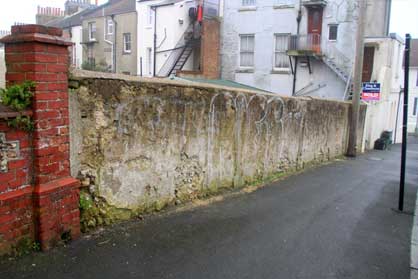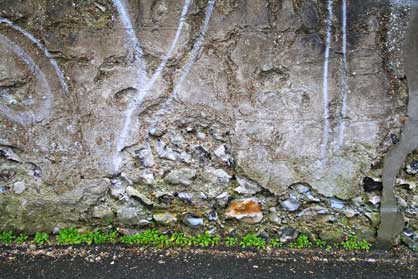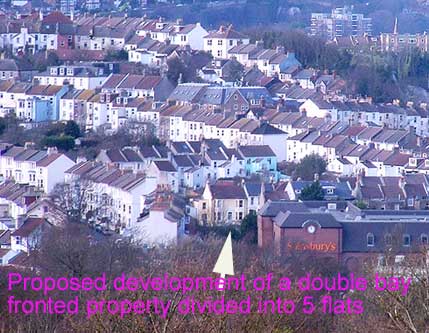Daubigny Rd and RH Crescent background
On Wednesday, 12th October 2016, applications BH2016/00752 (new build) and BH2016/00753 (listed building works affecting 1880s bungaroush wall) were both REFUSED by Brighton and Hove City Council's planning committee at their meeting in Council Chamber at Hove Town Hall. The meeting lasted from 2pm to nearly 9pm.
Subsequently the applicant appealed against refusal.
Review the appeal decision.
The Round Hill Society is grateful both to Ann Light and Cllr Louisa Greenbaum for speaking against the application on behalf of immediate neighbours and all who enjoy the views from D'Aubigny Road out of The Round Hill conservation area to the neighbouring hillside and the ridge of The Downs.
We also thank Cllr Hyde for the vital part she played in the decision by
- reading residents' comments and paying attention to important concerns
- instigating a site visit which allowed planning committee members to review concerns (loss of light to neighbours; the long view through the gap) with their own eyes, and
- speaking up for Round Hill during the meeting itself, ensuring that the problems of the applications were entered into the debate between members
Other planning committee members drew their own conclusions during the site visit which the majority of them had supported, though Cllr Hyde's contribution was noticed both at the meeting and by many Round Hill residents watching the meeting at home on their computers (via the webcam). Some relayed their thoughts on the proceedings to one another via Round Hill's Facebook social media.
Change in The Council's recommendation
At the request of Cllr Hyde, The Planning Committee used a new procedure (I believe for the first time ever!) allowing them to change the Officers' recommendation from "GRANT" to "REFUSE".
This is important to future planning history: if the applicant decides to APPEAL against REFUSAL, the planning history will now show that "REFUSE" has been the Council's recommendation on all applications to date in the garden of this listed property, except for the retrospective decision on the shed.
Neighbours' determination is a vital factor in planning campaigns, but it also needs a member of the planning committee to speak up for objectors to reverse a recommendation to "grant".
Those living near 101 Roundhill Crescent and all those who appreciate one of the best long views out of the Round Hill conservation area have Cllr Lynda Hyde to thank for doing just that. I believe that the implications of the applications on the amenity both of immediate neighbours and the costs to the conservation area probably got through to more than one of the planning committee members at Tuesday's site visit. Cllr Hyde is again to be thanked for requesting the latter.
The importance of site visits
Most members of the planning committee attended a site visit on the afternoon of Tuesday 11th October 2016. The weather was quite sunny, which highlighted concerns about "loss of light" if new-build in this sensitive location was approved. Cllr Lynda Hyde's account of what she observed during the site visit convinced most members that the proposed house would be very damaging to the amenity of No 4 D'Aubigny Road and No 103 Roundhill Crescent as well as to the Round Hill Conservation Area which would lose a much valued long public view. Cllr Hyde was able to quote policies -
- QD27 (protection of amenity)
- HE3 (development affecting the setting of a listed building) and
- HE6 (development within or affecting the setting of a listed building)
- and a couple of other policies
- as policy grounds for refusal.
The need for a site visit
The comment by Brighton and Hove City Council's Conservation Advisory Group (reproduced in 5.4. of the PLANS LIST advising the planning committee) is misleading and uninformed:
5.4 Conservation Advisory Group's [from The PLANS LIST]:
No objection. note that previous application for site was refused and that through the gap there is a view of the Lewes Road area, the cemetery and allotments and a view of Race Hill but considered that the predominant view is now the of Sainsbury’s and that the proposal would help to screen that out and only marginally reduce the vista.
The screening effect of an additional house would be precisely the opposite of that indicated by CAG.
A new house, abutting No 4 D'Aubigny Road (the edge of which can be seen to the left in the picture above) would block the long public view from its best vantage points where the smallest amount of Sainsbury can be seen. CAG's comment is also at odds with the concluding paragraph (9.4) of applicant's HERITAGE STATEMENT. This values the long view in spite of Sainsbury.
However, there are further concerns about the impact of Application BH2016/00752 , which I assume to be the focus of Councillor Hyde's recent request for a site visit:
- The bulk of the proposed house would also screen the rear patio and sunken back garden of No 4 D'Aubigny Road from afternoon sunlight.
- The rear gardens of several listed buildings (Nos 103-111) in Roundhill Crescent would also lose afternoon sunlight, as would windows on the rear facade of these properties.
Overshadowing: loss of afternoon sunlight to neighbouring properties / Overlooking
If successful proposal [BH2016/00752] would have harmful effects on neighbouring properties, reducing the amount of afternoon sunlight which can reach sitting-out areas, gardens and windows on the rear facade of several listed properties.
The proposed dwelling would:-
- jut out beyond the back of 4 D’aubigny Rd (including the living room) and block the open aspect of the kitchen door to the terrace, enclose the terrace and take out the amenity of light. No 4 D’aubigny Road would lose light from 6 windows and reflected light to more windows as the back of the house.
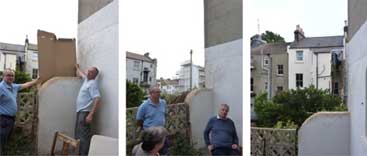
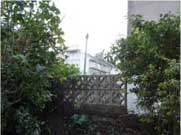
- overshadow the back garden of No 4 accessed by stepping down from the patio in the direction of Sainsbury and the green corridor. Being a sunken garden, the issue is worse than one might expect from the road.
- reduce the amount of afternoon sunlight available to properties with rear windows along that green corridor. This will affect the setting of the listed buildings at the east end of Roundhill Crescent and the amenity of their occupants (both present & future).
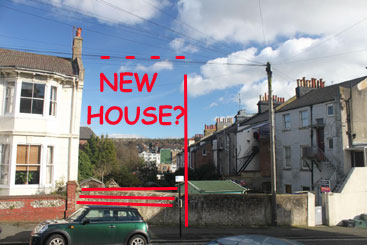
Overshadowing would result from the bulk of the proposed new structure and its position in the gap which supplies 4 D'Aubigny Road and the land of 103-11 Roundhill Crescent with afternoon light. The potential for overshadowing is increased because the land in this corridor falls away from the hill.
A gap with a purpose
which has always been there and is still needed for public amenity as well as the amenity of immediate neighbours
Several representations also focus on the amenity value of the long public view out of the conservation area from the south end of D'Aubigny Road. For many residents, long views between hillsides embody the distinctive feature which we want to preserve in our neighbourhood. They are as important as period architecture in defining what is pleasing about The Round Hill conservation area. There is another reason why filling this gap has never been permitted before, which relates to the preservation of reasonable amenity & neighbourliness an already very densely populated conservation area:
The gap, which has always separated the windowless end-of-terrace of No. 4 D'Aubigny Rd and the flats to the rear of 101 & 103 Roundhill Crescent),
- avoids close overlooking of several properties, and
- offers a long view from D'Aubigny over Woodvale and Tenantry Down rising to the ridge beyond. This contributes to the open-feel of our already very densely populated neighbourhood
A frequently quoted line from the song lyric BIG YELLOW TAXI by Joni Mitchell - "You don't know what you've got till it's gone" - advises listeners to value local amenities which have become so familiar that they are sometimes taken for granted.
Was there ever a No 2 D'Aubigny Road?
D'Aubigny Road resident, Annie Rimington, answers this in her comment:
During discussions at the planning committee about the previous application, references were made by the applicant and a councillor to the division of the plot on which 101 is built and the fact that there is not a 2 D’Aubigny Rd (where, on the east side of D’Aubigny Rd house numbering runs from 4 - 14). These comments wrongly inferred that the land on which the applicant hopes to build, was always intended for a ‘ 2 D’Aubigny Rd’. A copy of legal document drawn up in 1878 clearly shows the actual and intended plot sizes of 101 - 109 Roundhill Crescent at the full proportionate length they currently are. It also shows the redrawing of plots in D’Aubigny Rd to the builders of 4 & 6 D’Aubigny Rd. 6 D’Aubigny Road was designed and built for Arthur Cox (of Cox’s Pill Factory). The changes resulted in the plot for 6 D’Aubigny Rd increasing to 2 and half plots (ie plot numbers 4 & 6 and part of plot number 2) to allow for a double fronted house with a wide arched side entrance to the rear gardens/stables.
The leftover partial plot to the south of the ‘double plus’ fronted number 6 was combined with an old footpath which ran between D’Aubigny Rd along the north garden boundary of 101. The path is thought to have gone to a laundry on the site prior to Cox’s Pill Factory. This ‘newly drawn’ plot became the site number 4 when it was built to adjoin onto the Cox’s house. The street was re-numbered in 1881 (ESRO DB/D/27/213) and the use of number 2 was ended. There never was an intended number 2. I attach a copy of an excerpt of the legal document showing the plan.
The Cox’s house at number 6 included large gardens to the rear with its land running down to the Pill Factory. When the house was converted into flats in the 1980’s at the same time the Pill Factory site was sold to Sainsbury’s, the arched side entrance was filled in and became 6a. NB The Heritage Statement is once again incorrect in 2.15 where it is stated that 5 D’Aubigny Rd was built for Arthur Cox of Cox’s Pill Factory. 5 D’Aubigny Rd is much older and was originally a farmhouse.
THE COUNCIL'S GROUNDS FOR REFUSAL
Those given at the above link are for the applicant's first two proposals. Their third planning application which was also refused and is the subject of this APPEAL fails to address major grounds for previous refusals. They have not been addressed and they cannot be addressed on this open space which contibutes both to public views into and out of the conservation area and the amenity of neighbours. The gap brings sunlight to the vista of gardens and the rear windows & doors (main accesses for several flats) of several listed properties. It also provides an acceptable distance between ends-of-terraces to prevent close overlooking and loss of privacy.
-
- The building proposed in application BH2016/00752 (for which the appeal against refusal has been lodged) would still effectively block out a much valued long public view fronted by a historic section of wall along a vista forming the setting of several listed buildings. This long view, looking up to the ridge of the neighbouring hillside (and by no means trashed by the Sainsbury building) contributes to the open-feel of an already very densely populated neighbourhood and connects us with a wider section of E. Brighton. The view is best appreciated from the footway on the west side of D'Aubigny Road adjacent to No. 3 D'Aubigny Road. Photos taken from locations which highlight the Sainsbury building are not showing it at its best. If we don't protect the best, the attractions of our conservation area will be eroded and poor precedents will be established.
- The current proposal still brings development within the setting of a listed property uncomfortably nearer several flats, which would create a feeling of enclosure for the tenants living in those listed properties. There would be loss of afternoon sunlight to the rear of the listed houses at the east end of Roundhill Crescent, though the most unneighbourly impact of all would be to No 4 D'Aubigny Road. The rear patio of this property would be overshadowed by as the proposed building would jut out across the face of it. The sunken back garden, which is on lower terrain than the patio, would also be deprived of afternoon sunlight (as illustrated above).
- Approving this application could sound alarm bells for anybody living in an end-of-terrace house in Brighton and Hove. A window-less end of terrace (i.e. avoiding overlooking & loss of privacy) is a feature of our densely populated conservation area. Departing from neighbourly practices by replacing "blank facade on end" / "windows on row" with "windows on end" / "windows on row", while shortening the distance between "end" and "row", is a formula for bad feeling between neighbours. Saved Local Plan Policy QD27 attempts to avoid such discord. A single precedent where policy QD27 is ignored by planners could cause a spate of defensive planning applications. The message to residents would be:
"Don't risk loss of light to your patio or garden. Risk the disapproval of your immediate neighbours instead to protect your own amenity. Put a window in your end-of-terrace, because if you don't your Local Council could approve an application to graft an extra house onto the end of your building."
Approval of BH2016/00752 could result in a lot of work for the Enforcement Officer at the expense of all who pay Council Tax. The Council would also be boxed in if they wanted to refuse a retrospective planning application for an end-of-terrace window. Officers would know that if a refusal resulted in an appeal, appellants would be advised by their planning consultants to quote BH2016/00752 as a clear precedent (showing that BHCC is willing to waive policy QD27 even when neighbouring properties are badly affected) and to request consistency. The likelihood would then be that the appeal is dismissed and ratepayers (we!) would pay the appeal costs.
A two-way public view
Please help to save Brighton's best greenway from "truncation"
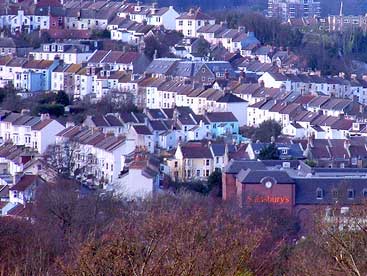
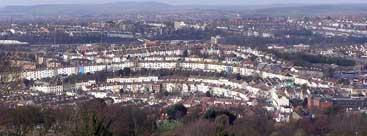
Viewed from the top of Bear Road, Round Hill's most spectacular green ribbon between Wakefield & Richmond Roads and Roundhill Crescent, continues (to the E of D'Aubigny Road) along the vista between the side of Sainsbury and the rear facade of several listed buildings connecting to Woodvale. The latter could shortly be compromised by unwanted infill.
The busy Lewes Road is not seen in the long public view (above).
This "ribbon of mainly garden" is actually one of Brighton's longest green corridors starting in The Old Steine, continuing through the Valley Gardens conservation to The Level, cutting through the green open space bounded by Park Crescent (see MAP) and forming the central green belt of The Round Hill conservation area as it threads its way to The Cat Creep and beyond, across the south end of Ashdown Road and into the gap fronted by the historic bungaroush wall at the south end of D'Aubigny Road. It connects with Woodvale Crematorium on the other side of The Vogue Gyratory so the green open space continues through Tenantry Down to Warren Road near Brighton Race Course.
Brighton is lucky to have such a long historic greenway. To grant permission to truncate this heritage asset (by building on the open space to the rear of 101 Roundhill Crescent on the E side of D'Aubigny Road) makes little sense. Severing a green vista behind listed buildings by erecting a single house offering dark and cramped living conditions would also create a sense of enclosure for several tenants who access their homes to the rear of 101 Roundhill Crescent, spoiling the open feel enjoyed by residents living in what is already a very densely populated neighbourhood.
There are better ways to address the housing crisis by sticking a building in a gap which has been conserved for good reason ever since the D'Aubigny Road terrace was laid out in the early 1880s. Previous applications to stick a house on this sensitive site (offering a precious view out of our conservation area) have been refused. It is very concerning that on this occasion the officers' recommendation is "to grant". This now requires an honest assessment by members of The Planning Committee (all elected Councillors) as to whether the previous reasons for refusal have been sufficiently addressed in the application now before them. I list these reasond (below) since reading any one of them makes it immediately clear that they haven't.
Heritage Statement: 101 Roundhill Crescent
Geoff Bennett's Heritage Statement is a fascinating read for people interested in the history of Round Hill, containing
- assessment of the heritage value of nearby properties in D'Aubigny Road and Roundhill Crescent
- an appraisal of the condition of 101 Roundhill Crescent as a heritage asset
- constructive suggestions on maintenance of the listed property, as well as
- an assessment of the value of our open spaces
On the gap between 4 D'Aubigny Road and the rear of 101 Roundhill Crescent, his statement concludes:
9.4 Whilst the view through the gap in the frontage in D’Aubigny Road created by the rear gardens of the Roundhill Crescent properties is not an identified vista in the Conservation Area Character Statement, it nevertheless makes a significant positive contribution to the character of the conservation area. However, it has been partially compromised by the Sainsbury supermarket development, which intrudes into this view and partly blocks the longer view to Race Hill and breaks the Downland ridgeline. Whilst this partial loss of the longer view is irreversible, the visual intrusion of the supermarket can be mitigated by tree planting in the rear garden of 101 Roundhill Crescent. Therefore, notwithstanding being compromised, this view is considered of medium heritage significance.
It is also the prerogative of Round Hill residents to express their own views on the amenity value of long views in & out of our conservation area across downland and listed vistas.
The rear of 101 Roundhill Crescent (to the right in the picture below) is already a very busy facade with a large number of windows and front doors to flats on different floors and associated external stairways. Even a small additional house between this facade and No 4 D'Aubigny Road is likely to result in overlooking, privacy issues and cramped accommodation, whereas the current gap provides welcome relief to several households as well as long public views connecting our conservation area with neighbouring suburbs.
Listed buiding consent - our living history
- The proposal for new-build falls within the setting of several listed buildings
- The generous stretch of 19th century bungaroush wall, which fronts the vista of gardens running behind the listed buildings, is also a heritage assett which deserves to be better looked after
English Heritage state on their website that "Listed building consent is required for all works of demolition, alteration or extension to a listed building that affect its character as a building of special architectural or historic interest. The requirement applies to all types of works and to all parts of those buildings covered by the listing protection (possibly including attached and curtilage buildings or other structures), provided the works affect the character of the building as a building of special interest."
The vista beyond the bungaroush wall in the above picture is within the setting of the listed building at 101 Roundhill Crescent, a setting which is clearly visible from D'Aubigny Road. Shutting off the long public view along the vista to the rear of the first houses to be erected in Roundhill Cresent (during the 1860s), would impact on the appreciation of the settings of several listed buildings.
Built in the 1860s, houses in the terrace extending from 101 to 113 Roundhill Crescent were listed at Grade 2 by English Heritage on 2 March 1981 for their architectural and historic importance. 101 Roundhill Crescent was rented by Dr Helen Boyle from 1905 to 1911 where she ran England's first hospital for the treatment of mental illness, known as The Lewes Road Hospital and Dispensary for Women and Children. See page 63 of ROSE HILL TO ROUNDHILL: A BRIGHTON COMMUNITY (ISBN 1-901454-08-8) or wikipedia article: Roundhill Crescent.
CABE Commission for Architecture and the Built Environment recommend a minimum separation of 20 metres between windows of existing homes to those of proposed homes to avoid situations of unacceptable overlooking. There are numerous windows and doors (some accesses) on the rear elevation of 101 Round Hill Crescent, but as with most ends-of-terraces in Round Hill, the side elevation of 4 D'Aubigny Road is blank with no windows, doors or other openings. Since there is little more than 18 metres between these two existing elevations, there is good reason for this practice. 101 Round Hill Crescent was originally used (but not built as) a women's and children's hospital, but has more recently been used as flats.
The bungaroush wall seen in the pictures (above and below) measures just over 14 metres. Although it has had some cement based repair, it is still mainly lime, pebbles and flints. See here for information on how a historic wall of this kind should be repaired. Although the main grounds for refusal relate to living conditions, a request for attention to be paid to retention and proper treatment of this wall could be included in your comments.
Refusals of the applicant's previous proposals
Click here to see the Council's reasons for refusing BH2015/02786. Go to page 100 of the document headed ITEM C.
Situation: Land to Rear of 101 Roundhill Crescent Brighton
Description: Erection of two storey, three bedroom dwelling (C3) as shown on the plan(s) and application submitted to the Council on 29 July 2015.
Application BH2015/00322 - planning decision 7th April 2015
Situation: Land to Rear of 101 Roundhill Crescent Brighton
Description: Erection of two storey building comprising of 5no one bedroom flats. as shown on the plan(s) and application submitted to the Council on 02 February 2015.
BH2015/00322 Land to the rear of 101 Round Hill Crescent
The proposed double-fronted house would have been on the same front building line as No 4 D'Aubigny Road which would have become the neighbouring property i.e. the new house would have continued the terrace, plugging 10 metres of the 18-metre gap between the existing end-of-terraces.
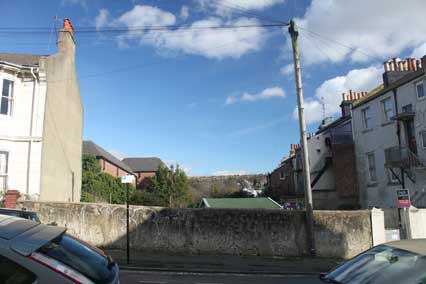
Plugging this significant long public view out of the Round Hill conservation area to the ridge of the next hillside above Tenantry Down, whether with a single-fronted or double-fronted house (with windows at each level on the side elevation facing the rear elevation of 101 Roundhill Crescent) would both be unneighbourly and would have an adverse affect on the amenity of all who appreciate views out of D'Aubigny Road - a little green relief within an already densely populated conservation area.
To gauge distances, the bungaroush wall extends approximately 14 M from the brick pillar to the white rendered pillar.
Gaps between ends-of-terraces contribute to privacy by containing overlooking to acceptable distances
- living conditions (privacy and outdoor amenity space) - the existing gap is there for a purpose and it is already the right size.
Good architectural practice is to have a minimum separation of 20M between windows of proposed & existing dwellings to protect against overlooking and loss of privacy. Application BH2015/00322 takes a gap where there is little more than 18 metres between the windowless side elevation of No 4 D'Aubigny Road and the rear of 101 Round Hill Crescent where there are multiple windows/doors/accesses. It is most surprising that the double-fronted house proposed (measuring about 10 metres itself), also has windows on all levels at the side!
The gaps left between Round Hill's ends-of-terraces contribute to the open-feel of an already very densely populated neighbourhood and permit long public views OUT OF the conservation area (e.g. from D'Aubigny Road - a public street) or INTO the conservation area (e.g. from Woodvale and Tenantry Down - public vantage points)
- The planning system does not let you object to loss of views from a person's private property. However, views enjoyed by the public from vantage points in public use (e.g. streets and hillsides) can be protected under policy HE6. The view now under threat looks over the bungaroosh wall, running along the mainly green vista to the rear of Round Hill Crescent, via Woodvale, up to Tenantry Down. It's a view which many users of D'Aubigny Road enjoy.
- Also not considered in Application BH2015/00322, is the bungaroush wall - part of Round Hill's visual and architectural history. This is similar to the walls bounding Woodvale and Downs Crematoriums and the City Cemetry running up each side of Bear Road. Although there has been some cement-based repair, the wall is still mainly lime, pebbles and flints. The wall is 15 metres in length and information on the correct way to repair it can be found here.
